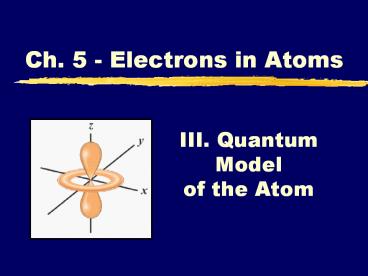III. Quantum Model of the Atom - PowerPoint PPT Presentation
1 / 21
Title:
III. Quantum Model of the Atom
Description:
Ch. 5 - Electrons in Atoms III. Quantum Model of the Atom A. Electrons as Waves Louis de Broglie (1924) Applied wave-particle theory to e- e- exhibit wave properties ... – PowerPoint PPT presentation
Number of Views:139
Avg rating:3.0/5.0
Title: III. Quantum Model of the Atom
1
III. Quantum Model of the Atom
- Ch. 5 - Electrons in Atoms
2
A. Electrons as Waves
- Louis de Broglie (1924)
- Applied wave-particle theory to e-
- e- exhibit wave properties
QUANTIZED WAVELENGTHS
3
A. Electrons as Waves
QUANTIZED WAVELENGTHS
4
A. Electrons as Waves
EVIDENCE DIFFRACTION PATTERNS
5
A. Electrons as Waves
- Diffraction (def) bending of a wave as it
passes by the edge of an object - Interference (def) when waves overlap (causes
reduction and increase in energy in some areas of
waves)
6
B. Quantum Mechanics
- Heisenberg Uncertainty Principle
- Impossible to know both the velocity and position
of an electron at the same time
7
B. Quantum Mechanics
- Schrödinger Wave Equation (1926)
- finite of solutions ? quantized energy levels
- defines probability of finding an e-
8
B . Quantum Mechanics
- Schrodinger wave equation and Heisenberg
Uncertainty Principle laid foundation for modern
quantum theory - Quantum theory (def) describes mathematically
the wave properties of e- and other very small
particles
9
B. Quantum Mechanics
- Orbital (electron cloud) each holds 2 e-
- Region in space where there is 90 probability of
finding an e-
10
C. Quantum Numbers
- Four Quantum Numbers
- Specify the address of each electron in an atom
11
C. Quantum Numbers
- 1. Principal Quantum Number ( n ) positive whole
integers - Main Energy level
- Size of the orbital
- n2 of orbitals in the energy level
12
Principle Quantum Number
- As n increases, the e- energy and distance from
the nucleus increases - More than 1 e- can have the same n value
13
C. Quantum Numbers
- 2. Angular Momentum Quantum ( l )
- Energy sublevel
- Shape of the orbital
- Values 0 to (n-1)
14
C. Quantum Numbers
If l equals Then orbital shape is
0 s
1 p
2 d
3 f
Principle quantum followed by letter of
sublevel designates an atomic orbital
15
C. Quantum Numbers
- 3. Magnetic Quantum Number ( ml )
- Orientation of orbital
- Specifies the exact orbitalwithin each sublevel
16
C. Quantum Numbers
px
py
pz
- Values are -l 0 l
17
C. Quantum Numbers
- Orbitals combine to form a spherical shape.
18
C. Quantum Numbers
- 4. Spin Quantum Number ( ms )
- Electron spin ? ½ or -½
- An orbital can hold 2 electrons that spin in
opposite directions.
19
C. Quantum Numbers
- Pauli Exclusion Principle
- No two electrons in an atom can have the same 4
quantum numbers. - Each e- has a unique address
1. Principal ? 2. Ang. Mom. ? 3. Magnetic
? 4. Spin ?
energy level sublevel (s,p,d,f) orbital electron
20
C. Quantum Numbers
- n of sublevels per level
- n2 of orbitals per level
- Sublevel sets 1 s, 3 p, 5 d, 7 f
21
Feeling overwhelmed?
Read Section 5-2!

